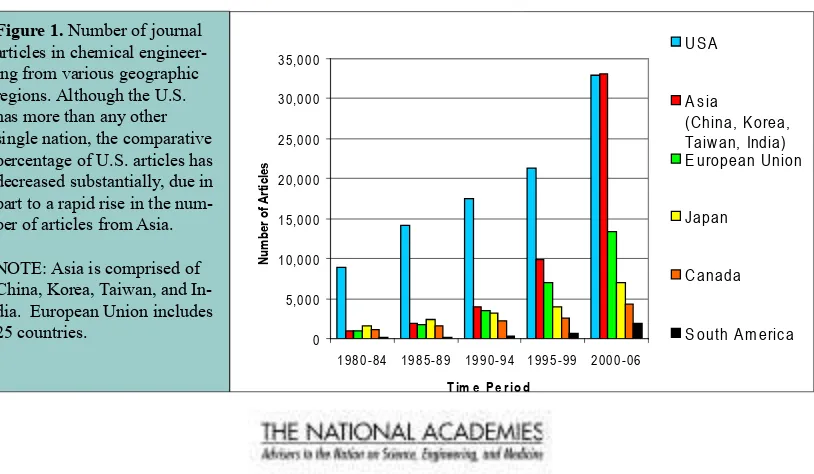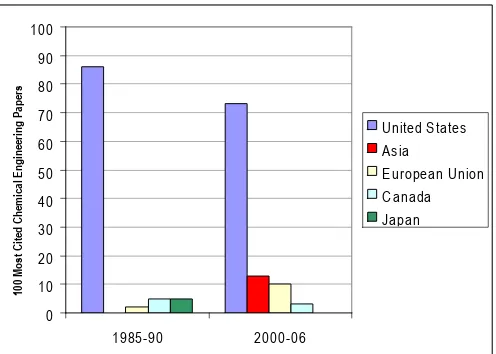International Benchmarking of U.S. Chemical
Engineering Research Competitiveness
This report highlights the main indings of a benchmarking exercise to rate the standing of U.S. chemical engineering relative to other regions or countries, key factors that inluence U.S. performance in chemical engineering, and near- and longer-term projections of re-search leadership.
M
ore than a quarter of the jobs in the United States depend on chemistry in one way or another, and over $400 billion worth of products rely on innovations from this ield. Chemical engineering, as an academic discipline and profession, has enabled the science of chemistry to achieve this level of signiicance. However, over the last 10-15 years, concerns have been raised about the identity and future of the U.S. chemical engineering enterprise, stemming from the globalization of the chemical industry; expansion of the ield’s research scope as it interfaces with other disciplines; and narrowing of the ield’s ability to address important scientiic and technological questions covering the entire spectrum of products and processes—from the macroscopic to molecular level.At the request of the National Science Foundation, the National Research Council con -ducted an in-depth benchmarking analysis to gauge the current standing of the U.S. chemical engineering ield in the world. The benchmark measures included: 1) the development of a Virtual World Congress comprised of the “best of the best” as identiied by leading international experts in each subarea, 2) analysis of journals to uncover directions of research and relative levels of re -search activities, 3) analysis of citations to measure the quality of re-search and its impact, and 4) the quantitative analysis of trends in degrees conferred to and employment of chemical engineers, and some other measures including patent productivity and awards.
The United States is presently, and is expected to remain, among the world’s leaders in all subareas of chemical engineering research, with clear leadership in several subareas. U.S. leadership in some classical and emerging subareas will be strongly challenged.
Figure 1. Number of journal
articles in chemical engineer
-ing from various geographic regions. Although the U.S.
has more than any other
single nation, the comparative percentage of U.S. articles has
decreased substantially, due in part to a rapid rise in the
num-ber of articles from Asia.
NOTE: Asia is comprised of China, Korea, Taiwan, and In
-dia. European Union includes
25 countries. 0
5,000 10,000 15,000 20,000 25,000 30,000 35,000
1980-84 1985-89 1990-94 1995-99 2000-06
T im e Pe r io d
N
umber
of A
rticles
U S A
A s ia (C hina, K orea, Taiw an, India) E uropean U nion
Japan
C anada
This brief was prepared by the National Research Council based on a report by the Committee on Benchmarking the Research Competitiveness of the United States in Chemical Engineering. The report was sponsored by the National Science Foundation. For more information, contact the Board on Chemical Sciences and Technology at (202) 334-2156 or visit http://dels.nas.edu/bcst. Copies of International
Benchmarking of U.S. Chemical Engineering Research Competitiveness are available from the National
Academies Press, 500 Fifth Street, NW, Washington, D.C. 20001; (800) 624-6242; www.nap.edu. The United States is currently among world
leaders in all of the subareas of chemical engineer -ing research identiied in the report, and leads in both classical subareas such as transport processes as well as emerging areas such as cellular and metabolic engi -neering. Although the comparative percentage of U.S. journal articles has decreased substantially (See Figure 1), the quality and impact still remain very high and clearly in a leading position. For example, 73 of the 100 most cited papers in chemical engineering litera -ture during the period 2000-2006 came from the United States (see Figure 2). In addition, the United States leads in the percentage of journal articles with 100 or more citations. As a result, the United States is expect -ed to maintain its current position at the “Forefront” or “Among World Leaders” in all subareas of chemi -cal engineering research, and to expand and extend its current position into subareas such as biocatalysis and protein engineering; cellular and metabolic engineering; systems, computational, and synthetic biology; nano -structured materials; fossil energy and extraction and processing; non-fossil energy, and green engineering. U.S. leadership in some classical and emerging subareas will be strongly challenged.
U.S. leadership in the core areas of transport processes; separations; catalysis; kinetics and reaction engineering; process development and design; and dynamics, control, and operational optimization is now shared with Europe and in some cases Japan, as shown by decreases in U.S. journal articles and citations. Japan and other Asian countries are particularly competitive in the materials-oriented research, e.g., polymers, inorganic and ceramic materials, biomaterials, and nanostructured materials. Europe is also very competitive in the bio-related subareas of research, while Japan is particularly strong in bioprocess engineering. The report’s authoring committee views the current research trends as healthy, but at the same time, is concerned about the progressive decline of the U.S. position in the core areas, because it is strength in fundamentals that has enabled generations of chemical engineers to create new and highly
competitive technologies for processes and products.
Factors signiicantly affecting the leadership position of the United States in the future.
The range of chemical engineering research over many spatial and temporal scales, across a broad range of products and processes, and throughout a variety of industries and social needs it serves, has led to innova-tion and competitiveness but is presently at risk. Most biotechnology and nanotechnology technologies being explored today rely on traditional chemical engineering for implementation. Creating conditions for a more balanced approach that safeguards the dynamic range of chemical engineering research is critical to address -ing national needs in energy and the environment and preserving U.S. competitiveness in the future. Future U.S. leadership in chemical engineering is not guaran -teed. Many factors could signiicantly affect the posi -tion of the U.S., and include shifting funding priorities by federal agencies, reductions in industrial support of academic research in the United State, and decreases in talented foreign graduate students, among others.
Permission granted to reproduce this document with no additions or deletions.
Copyright 2007 The National Academy of Sciences
Figure 2. Contributions to top 100 most cited chemical engineer
-ing journal articles. In recent decades, the United States has been a strong leader. It is noteworthy that in 2000-2006, 13 of the 100 most cited papers were contributions from Asia.
NOTE: Asia is comprised of China and Korea, and the European Union includes 25 countries. This igure was derived from data in Table 3.3 of the report.

